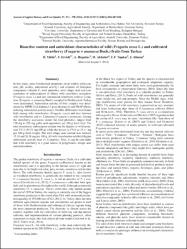Bioactive content and antioxidant characteristics of wild (Fragaria vesca L.) and cultivated strawberry (Fragaria x ananassa Duch.) fruits from Turkey

View/
Access
info:eu-repo/semantics/openAccessDate
2014Author
Yıldız, HalitErcişli, Sezai
Hegedus, Adam
Akbulut, Mustafa
Topdaş, Elif Feyza
Aliman, Jasmina
Metadata
Show full item recordCitation
Yildiz, H., Ercisli, S., Hegedus, A., Akbulut, M., Topdas, E.F., Aliman, J. (2014). Bioactive content and antioxidant characteristics of wild (Fragaria vesca L.) and cultivated strawberry (Fragaria x ananassa Duch.) fruits from Turkey. Journal of Applied Botany and Food Quality, 87, 274-278. https://doi.org/10.5073/JABFQ.2014.087.038Abstract
In this study, some biochemical properties (total soluble solid content, pH, acidity, antioxidant activity) and contents of biological compounds (vitamin C, total phenolics, total ellagic acid and concentration of anthocyanins) of fifteen wild strawberry accessions (Fragaria vesca L.) and one commercial strawberry cultivar Camarosa (Fragaria x ananassa Duch.) sampled in Northeastern Turkey were determined. Antioxidant activity of fruit samples was determined by DPPH (2,2-diphenyl-1-picrylhydrazyl) and FRAP (Ferric reducing antioxidant power) assays. Notable differences were found both among wild strawberries (Fragaria vesca) and also between wild strawberries and cv. Camarosa (Fragaria x ananassa). Among the strawberry accessions tested, the total phenolics ranged from 138 mg to 228 mg gallic acid equivalent per 100 g fresh fruit. the total monomeric anthocyanin content was the highest in wild accession FV-2 (53.51 mg/100 g) while the lowest in FV-6 as 25.11 mg per 100 g fresh weight. the total ellagic acid content was between 15.18 and 26.36 mg per 100 g. All wild strawberries exhibited higher antioxidant activity than cv. Camarosa. Thus, it can be concluded that wild strawberry is a good source of polyphenols, ellagic acid and antioxidants.

















